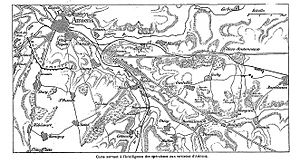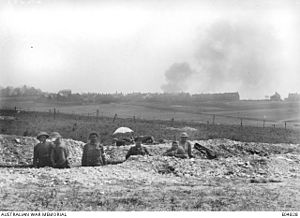First Battle of Villers-Bretonneux facts for kids
Quick facts for kids First Battle of Villers-Bretonneux |
|||||||
|---|---|---|---|---|---|---|---|
| Part of Operation Michael (German spring offensive) | |||||||
 |
|||||||
|
|||||||
| Belligerents | |||||||
The First Battle of Villers-Bretonneux was an important fight during World War I. It happened from March 30 to April 5, 1918. This battle was part of a big German attack called Operation Michael. This operation was a major part of the German spring offensive on the Western Front.
The German army wanted to capture the town of Villers-Bretonneux in northern France. This town was very important because it was close to Amiens. Amiens was a key city with important roads and railway lines. If the Germans took Villers-Bretonneux, they could then use their artillery to attack Amiens.
British and French soldiers were pushed back by the German attack. To help, Australian troops were sent from Belgium. They arrived in late March. In early April, the Germans launched a strong attack to take Villers-Bretonneux. British and Australian soldiers defended the town bravely. The Germans almost succeeded. However, a counter-attack by Australian and British troops on April 4 saved the day. They pushed the Germans back and stopped their advance towards Amiens. This battle was a victory for the British and their allies.
Contents
Why This Battle Happened
In early 1918, a big change happened in World War I. Russia stopped fighting, which meant the war on the Eastern Front was over. This allowed Germany to move many of its soldiers and a lot of equipment to the Western Front.
The German commander, Erich Ludendorff, decided to launch a major attack. He wanted to win the war before more American troops arrived to help the Allies. On March 21, 1918, Germany started Operation Michael. This attack targeted the weakest part of the British lines near the Somme River. By April 5, the Germans had taken about 60 kilometers (37 miles) of land from the British. They also launched two other attacks, but all three were eventually stopped by the Allies.
The Battle for Villers-Bretonneux
As the German army advanced in late March 1918, they moved closer to the important railway hub at Amiens. This forced the British lines to fall back towards the town of Villers-Bretonneux. On March 29, the 9th Australian Brigade was sent to help. This group of four infantry battalions came from Belgium. Their job was to stop the Germans from breaking through the lines between the British Fifth Army and the French First Army.
On March 30, the Germans attacked near Le Hamel. This attack was pushed back, but the Germans did gain some ground around Hangard Wood. Five days later, the Germans tried again to capture Villers-Bretonneux. Part of their attack hit the French First Army. The French soldiers had to retreat, but they soon fought back and regained much of their lost ground.
The battle line was held by British and Australian troops. These included the British 14th (Light) Division, the 35th Australian Battalion, and the British 18th (Eastern) Division. By April 4, the 14th (Light) Division near Le Hamel had been pushed back by the German 228th Division. The Australians held off the German 9th Bavarian Reserve Division. The 18th (Eastern) Division also fought back against other German divisions. The British had to pull back when the 14th (Light) Division retreated. This left a gap in their lines.
The line west of Le Hamel was strengthened when the 15th Australian Brigade arrived. In the afternoon, the Germans attacked again. They pushed the 18th (Eastern) Division back in the south. It looked like Villers-Bretonneux was about to fall. The Germans came within 400 meters (440 yards) of the town.
However, Colonel Goddard of the 35th Australian Battalion decided to launch a surprise counter-attack. This happened late in the afternoon of April 4. The 36th Australian Battalion, with about 1,000 men, led the charge. They were supported by a company from the 35th Australian Battalion and the 6th Battalion London Regiment. They advanced quickly, pushing the Germans back towards Monument Wood and then north of Lancer Wood. This forced two German divisions to retreat from Villers-Bretonneux. Other British cavalry and Australian infantry from the 33rd Battalion and 34th Battalion helped secure the gains made by the Australians.
What Happened After the Battle
Soldier Losses
The 9th Australian Brigade had about 2,400 soldiers killed or wounded out of 3,500 who fought. The exact number of German casualties is not known, but two of their regiments involved had between 8,000 and 10,000 losses. The 9th Australian Brigade reported about 4,000 German soldiers killed on their part of the front. The 18th (Eastern) Division also had many losses but managed to capture 259 German prisoners.


